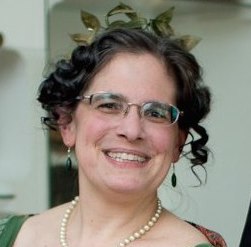Here’s an easy and interesting quadrille taken from Lowe’s Ball-Conductor and Assembly Guide, Third Edition, published in Edinburgh by the “Messers. Lowe.” The manual is not dated, but internal references and the type of dances included suggest that it is from the late 1820s or early 1830s. Given the era, I would expect to dance the figures with early nineteenth century quadrille steps, but the steps and sequences required are few and easy.
The Gallopade Quadrille, or Quadrille Galope, is for the usual four couples in a square and consists of three figures, each with three parts. The format of each figure is:
16b Galopade
16b Various quadrille figures
16b Sauteuse
This gives a length of 48bx3. Following the third figure, the dancers continue to sauteuse until the end of the music.
12/16/10: Edited to add: I was unclear above — the original dance instructions are entirely continuous throughout rather than broken down into separate figures with pauses in between like a typical quadrille. I noticed the repeating galop-figure-sauteuse pattern and used that structure in my writeup. There is no indication of any break or pause at any point in the entire sequence. My thanks to Oleksiy for raising this point in the comments.
I have no specific music for this dance, but using a piece of music at least 16b x 10 (160 bars) long will allow for the standard eight bars at the beginning for bows and an additional eight bars for the final sauteuse. Lengthier music will permit a longer sauteuse at the end.
Taking the parts piece by piece:
I. The Gallopade
All four couples galop around the set. I have previous discussed how to dance the galop. Two options are given:
(1) An eight-slide galop (4b) along each side, making a turn at the corners so that each length of a side is alternately danced the first or second foot leading (“towards hands” and “over elbows”).
(2) A four-slide galop (2b) with no turn at the end, followed by a full turn (2b); in effect, a six-slide galop and half-turn plus half of a polka turn, which means the length of each side of the quadrille is always danced with the first foot leading.
The choice is dependent on the size of the room, with the first being preferred for larger rooms and the second for smaller.
A further tip:
In dancing either sort of Gallopade, the gentlemen stamp, or not, in making the chassés forward, at pleasure.
II. The Figures
Each of the three middle sections of the dance consists of the head couples performing a figure for eight bars, followed by the side couples repeating it. In order, the three figures are:
1. Chaîne anglaise (rights and lefts)
2. Ladies chain
3. Promenade
All three are done fully — across and back, and may be done with the same step-sequence of Chassé–Chassé–Chassé–Jeté-Assemblé twice, though the side couples will have to fudge the final Jeté-Assemblé somewhat in order to assume ballroom position for the sauteuse. All three figure would indeed be “broken” into two parts rather than flowing straight through. Rights and lefts would include taking both right hands and left. The promenade hold is all hands in front, right in right and left in left. My aesthetic preference, in the absence of specific instructions, is for the Jeté-Assemblé sequences in the rights and lefts and ladies chain to be done holding left hands and facing one’s partner, with traveling occuring only on the Chassé steps.
A quick and dirty summay of how to perform each of these steps, not including all the niceties of bending and rising required for true excellence in period practice:
Chassé: after an initiating hop on the left foot on the upbeat (“and”) during which the right foot is extended forward, step with the right foot forward into fourth (“ONE”), close the left foot behind it (“and”), and move the right foot forward again (“TWO”). This move takes an entire bar (and-ONE-and-TWO).
Jeté: extend one foot out directly to the side (second position raised) and back in, either behind or before, leaping onto it and raising the other foot to point straight down, close along the leg. This is a sharp “out and in” motion rather than a curving ronde de jambe. Practice flicking the foot in and out of second position raised will be useful. The step is initiated on the upbeat (“and”) and lands on the downbeat (ONE).
Assemblé: extend one foot out directly to the side (second position raised) then bring it in either behind or before while hopping into the air, landing in either third or fifth position with weight equally on both feet, bending the knees slightly when landing rather than locking them. Again, this is an “in and out” motion. The step is initiated on the upbeat (“and”) and lands on the downbeat (TWO).
III. The Sauteuse
Lowe’s is not terribly specific in how to perform the sauteuse waltz, merely stating that
The Sauteuse, or Jumping Waltz, is performed by making a jetté [sic] or spring from one foot to the other every time the step is performed.
I would interpret this in the style of the Regency sauteuse, with the first step being leapt and the second and third slid. This is a duple-time waltz rather than a triple, with the rhythm ONE-and-TWO-(and). An audio sample of sauteuse music may be found on the website for the Spare Parts CD, The Regency Ballroom. A more detailed explanation of its performance will have to await another post.
Note that the head couples must be prepared to leap from the sauteuse waltz straight into the performance of each quadrille figure; the gentlemen in particular will have to fudge their feet slightly in order to step out on the right foot.
Special thanks to Nora, Lynn, Juliette, BDan, Beth, Kat, Emily, and Alexia for being my dance-testers for this quadrille!


Leave a Reply